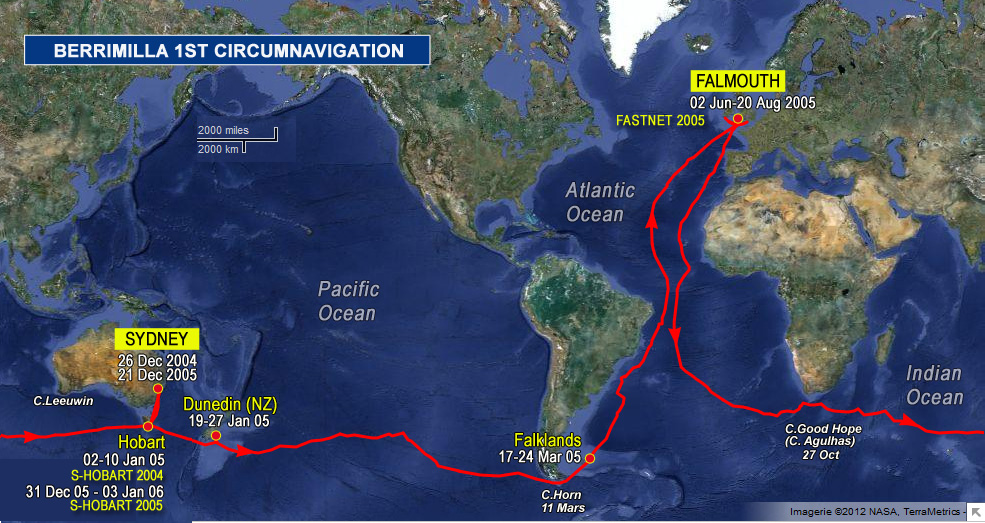0530hrs 27 Sep 2005 UTC 15’24”S 027’06”W Ref 387
I’ve been taken to task (what’s the derivation of that expression?) for leaving out Australian and Kiwi round the worlders from my mind picture of all the sailing vessels passing here over the centuries – so, apologies to Kay Cottee, Naomi James, David Adams, Don Mcintyre and Peter Blake – to name a few. And I got Connie van Rietschoten wrong too, but who wouldn’t? He won the first two (I think) Whitbreads in boats called Flyer and he was reported to have told his crews that if they went overboard in the southern ocean, he would not turn back to look for them. A practical man!
We’re plugging on through the night. Going through a series of squalls about 20 miles apart with 35 knots and pretty vicious seas. Uncomfortable, frequent sail changes and quite hard work just to hang on – you have to do everything one handed while holding on grimly with the other, your toes and eyebrows too. Berri banging through the seas as well, but short of slowing down to 3 knots or so, we can’t do much about it. Would be trivial but for the seas.
Have not yet seen the Southern Cross – it has been cloudy to the south for days. Clearing as I write now, so will go up and have a squizz and make a cuppa with some dunkers. Which done, I have to report that things change out here rather fast. I went up into the cockpit with my cuppa to find the sky completely overcast again.
I know I’ve been banging on about this a lot in these logs – and I’m going to do it some more: Nelson said of Cook that you had to be familiar with the sea to appreciate the magnitude of Cook’s achievements. As someone now reasonably familiar with the sea and going back to that mind picture of all the ships here together and then transporting the picture to the North Atlantic, a Viking longship was a marvellous vessel for its time – seaworthy, fast and rugged and it almost certainly got to Newfoundland via Greenland long before Columbus found the West Indies. Think, though, of the conditions for the crews on those voyages. Berrimilla is a tiny world, but enclosed, relatively dry, very uncomfortable but bearable for very long periods, with sophisticated watermaking technology and safely preserved food and the space to store enough to last for at least a year as long as the water holds out. And she sails very efficiently to windward, with GPS to record every twitch of her wake. A longship was open, the crew sat on thwarts or on a deck below the thwarts in the spray and the rain where they also slept, probably in running water for a lot of the time. They had to bail with buckets. Their sails were made of wool and could not sail better that about 45 degrees to the wind, their wet weather gear was cowhide and they had to store water in casks and food preservation technology was salting and drying. One of those in a North Atlantic storm would have been desperately frightening and cold, with the crew unable to cook food and close to death from exposure and starvation. And on top of all this, the captains had not only to preserve their vessels and crews on the way out but also remember how they got there and then find their way back and pass on the knowledge. No GPS, no instruments, probably no facility for writing, no charts. I don’t know whether any of the longships ever got back from Newfoundland but it would have been an astonishing achievement if they did. A nation’s capacity for empire building – or theft on a grand scale if you are a revisionist – depended on this capacity to get superior technology into action in distant places and then get home again with the spoils and the knowledge.
Closer to where we are now, there’s an account of this process written by Bernal Diaz, who was one of them, of Hernando Cortez’ destruction of the Aztecs with his few hundred soldiers and sailors and their guns, horses and armour (and considerable local help) not very long after Columbus first found his way back to tell them how to get there. I read it as a schoolkid and wondered then – but not half as much as I wonder now. I might bang on a bit more about rutters and charts and computers in another update.

 The logs ramblings can be cryptic, so we have added:
The logs ramblings can be cryptic, so we have added: